The week at a glance
- Amur Falcon identified retrospectively in East Yorkshire
- Bobolink on Scilly
- Red-flanked Bluetail on Scilly
- Rose-breasted Grosbeak in County Clare
- Black-browed Albatross off County Cork
- Little Blue Heron still in County Galway
- Grey-cheeked Thrush and Sociable Lapwing still on Scilly
- White-throated Sparrow in County Cork
- White's Thrushes on Shetland and in Aberdeenshire
Finally, a little respite in an October that has left many breathless at the sheer weight of outstanding birds. The brisk-moving low-pressure system that shifted rapidly across the top of the country produced a couple of new Nearctic arrivals falling off the bottom of it, but they had little impact as so many people were talking about a significant shock of mega proportions.
Countless numbers of birders will have a tale about "the one that got away". A briefly seen warbler darting in to a bush, never to appear again, a warbler which you know was desperately rare. A fly-by seabird, lost in a trough, which you just know was something rather special. A roosting flock of gulls disturbed to the skies just as you latch on to what may have been the find of a lifetime. But the "one that got away" in East Yorkshire in the autumn of 2008 had been on offer for a mammoth 32 days.

Amur Falcon, Tophill Low NR, East Yorkshire (Photo:
Dave Mansell)

Amur Falcon, Tophill Low NR, East Yorkshire (Photo:
Dave Bryan)
The moulting first-summer male Red-footed Falcon at Tophill Low Reservoir (East Yorkshire) was last seen on Wednesday October 15th, but it was only on Saturday October 18th, when new photos of the bird were posted on the BirdGuides picture gallery, that the newly moulted, diagnostic underwing pattern could finally been seen in all its glory. This was no Red-foot, this was the first Amur Falcon for Britain! Closer examination of other flight shots suggest that perhaps the odd white axillary was visible on October 2nd (though it is highly unlikely that this could be seen in the field), but shots taken on October 8th (but posted only on October 19th) clearly show areas of pure white around the axillaries and underwing coverts; and in retrospect, shots from earlier in the bird's stay seem to show relatively pale underparts, a suggestion of white along the edge of the closed wing and a rather strong moustachial, all possible pointers to Amur (features shared though with Red-footed Falcon). Diligent birders had visited Tophill looking at this bird with the specific hope that it may prove to be an Amur but, until the underwing pattern moulted through, it would have been a very tough (and pretty brave) call. Like other sporting "chokes", Don Fox's last-minute missed Challenge Cup kick, Devon Loch suddenly spread-eagled on the Aintree turf or Newcastle United blowing the Premiership title, it's no one's fault really, you can't actually blame anyone. Its just one of those things—a case of some you win (Long-billed Murrelet the obvious example) and some you lose. Luckily for birders, there'll be another one. Probably.

Sociable Lapwing, St. Mary's, Isles of Scilly (Photo: Martin Goodey)
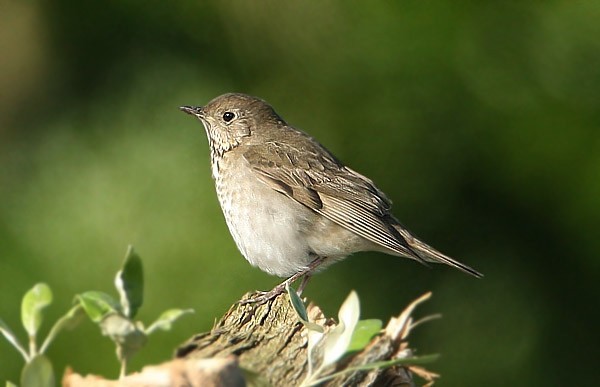
Grey-cheeked Thrush, St. Agnes, Isles of Scilly (Photo: Gary Thoburn)

White-throated Sparrow, Cape Clear, Cork (Photo: Sean Cronin)
The 21st proved to be one of those classic Scilly days when worlds collide. From the west came a Bobolink (the third of the autumn) on St. Agnes and, just over an hour later, from the east, came the second "first" for the islands this month, in the always-glorious form of a Red-flanked Bluetail on St. Mary's. A typical "which way should I go" moment for Scilly veterans, made harder if you decided to twitch the Bobolink, not see it and arrive back too late for the Bluetail...ouch! The low-pressure system that finally produced the Bobolink also produced another five-star bird for Loop Head (Co. Clare) this week—hot on the heels of last week's Philadelphia Vireo, this time it was a (rather more predictable) Rose-breasted Grosbeak on 22nd that meant that plenty of birders were heading towards Kilbaha once more. This was the first record for Clare (although one seen at Loop Head in October 2000 hasn't appeared in print), the ninth for Ireland and the first since a female on Great Blasket, off the coast of Kerry, in September 2000. This Grosbeak further enhances the remarkable similarities to the autumn of 1985—but where are the Northern Parulas? (And let's not go near Chestnut-sided Warbler and Wilson's Warbler!) Dropping down in to County Cork, the 21st saw one of the ultimate seawatching prizes, a Black-browed Albatross, fly past Mizen Head in the last hour of daylight. Could it be the bird seen off the Irish coast during the summer or is there another lurking out there? Staying in Ireland, over in County Galway, the Little Blue Heron remained in Barnaderg Bay, Letterfrack until 16th. What seemed to be a sudden departure surprised many who expected the bird may "do a Snowy Egret" and linger for the winter. Then, as if by magic, on 21st, the bird was back in the bay! Where had it been? And is the wintering option back on? Time will tell. Back on Scilly, the island's first Sociable Lapwing remained on St. Mary's (generally around the fields at Telegraph) until the middle of the day on 20th, while on neighbouring St. Agnes, the Grey-cheeked Thrush found late last week settled down to perform well from 17th–22nd (having gone missing on 15th and 16th). Across the Irish Sea once more to County Cork, where the first-winter White-throated Sparrow on Cape Clear Island remained to 18th, while up on Shetland, the White's Thrush remained at the Kergord Plantation, Mainland to 18th and was followed by another bird (number seven for the autumn, since the first out on Inishbofin on 29th September) found in the grounds of the Parkhill Estate, Dyce (Aberdeenshire) on 18th–19th.

Grey Phalarope, North Ronaldsay, Orkney (Photo: Paul A Brown)
The adult White-billed Diver first seen at the start of July was still being seen in the waters off South Ronaldsay (Orkney) until 22nd. Some 50 Balearic Shearwaters were recorded this week, with 10 off Prawle Point (Devon) on 19th and 13 past Berry Head (Devon) on 20th the highest counts noted. Numbers of Sooty Shearwaters were boosted hugely by the 200 or so seen off Mizen Head on 21st, with only a further 25 birds noted elsewhere; 10 from Labost, Lewis (Outer Hebrides) on 16th was the next highest count. Grey Phalaropes chalked up around 100 birds this week, with 10 seen from the Scillonian III early in the week and off North Ronaldsay (Orkney) on 21st, 13 off Griminish Point, North Uist (Outer Hebrides) on 18th and 15 from Cape Clear Island (Co. Cork) on 16th, all outdone by 20 from Kilcummin Head (Co. Mayo) on 16th. Over a dozen Leach's Storm-petrels included eight birds seen from assorted Hebridean headlands, and singles in Lincolnshire, Lancashire, Suffolk and Dorset. Three Long-tailed Skuas were seen this week: off Labost, Lewis on 16th, at Baile na hAbhann (Co. Galway) on 19th and at Workington (Cumbria) on 20th. Seawatchers at Kilcummin Head scored 86 Pomarine Skuas on 16th and this was easily the highest total of the week, although 18 off Cley (Norfolk) was notable, several resplendent adults passing close inshore. Single Sabine's Gulls were seen off Kilcummin Head on 16th, off St. Agnes (Scilly) on 19th and at Loch Ryan (Dumfries & Galloway) on 20th. Eight Little Auks were seen off Porthpean (Cornwall) on 18th and one was reported off Poole (Dorset) on 20th with another off Fair Isle (Shetland) on 21st.

Cattle Egret, Lanercost, Cumbria (Photo: Frank Golding)

Great White Egret, Minsmere RSPB, Suffolk (Photo: Mike Parker)

Spoonbill, Brownsea Island NT, Dorset (Photo: Gavin Farnell)

Glossy Ibis, Pilmore Strand, Cork (Photo: Sean Cronin)

Common Crane, Bantry, Cork (Photo: Sean Cronin)
The four Cattle Egrets seen last week at Pagham Harbour (West Sussex) were still present to 17th and five birds were seen around Meare Heath (Somerset) on 16th–17th. On 19th, four birds were seen at Rye Harbour NR (East Sussex) and were still present there on 22nd. Singles were seen on Studland Heath (Dorset) on 18th–19th and, also on 18th, birds were found at Lanercost (Cumbria) and the fourth Cattle Egret for Pembrokeshire was found at Sandy Haven (whilst birders searched for a Great White Egret!). Another Cattle Egret was seen at Bantry (Co. Cork) on 22nd. The aforementioned Great White Egret in Pembrokeshire was seen on the Gann Estuary in the early part of the week, and may have been the bird that appeared at Ynys-hir (Ceredigion) on 18th. The Great White Egret remained at Blashford Lakes (Hampshire) from 16th–18th, while in Suffolk the French colour-ringed bird was still at Minsmere from 17th–22nd. Also on 17th, another arrived at Abberton Reservoir (Essex), while on 19th, the final bird of the week was seen at Fota (Co. Cork). Around 30 Spoonbills were seen during the week, with 15 birds remaining around Brownsea Island (Dorset) to 17th and half a dozen birds at Isley Marsh (Devon) to 22nd. Notable singles were seen in Cambridgeshire (at Wicken Fen) on 16th and in Cumbria (at Walney Island) on 18th. In West Yorkshire, the adult Glossy Ibis was still to be seen around Swillington Ings from 17th–19th, with another at Pilmore Strand (Co. Cork) on 21st–22nd. Also on 21st, single Glossy Ibises were reported from Belvide Reservoir (Staffordshire) and Rainham Marshes (London). Common Cranes included two still at Welney (Norfolk) on 16th, three over Oulton Broad (Suffolk) on 17th and one that spent 20th–21st at Ballylickey (Co. Cork) before moving to Crewe Bay on 22nd. Two single Corncrakes were seen on Scilly: on St. Agnes on 16th and St. Mary's on 18th.

Cackling Canada Goose, Caerlaverock WWT, Dumfries & Galloway (Photo: Tristan Reid)
At Caerlaverock in Dumfries & Galloway, a Taverner's Canada Goose was seen again on 16th and 22nd, while the diminutive Cackling Canada Goose (form minima) left the Barnacle Geese behind, joining up with the feral Canada Geese this week, but still managed to generate interest for those hoping for some armchair action in the future. Reports on 22nd suggested that two minimas have been present recently. In Lancashire, the adult Ross's Goose was seen at Rainford on 18th–19th and a white adult Snow Goose was at Meikle Loch (Aberdeenshire) on 22nd. The first Black Brant of the autumn was found at Dungarvan (Co. Waterford) on 22nd.
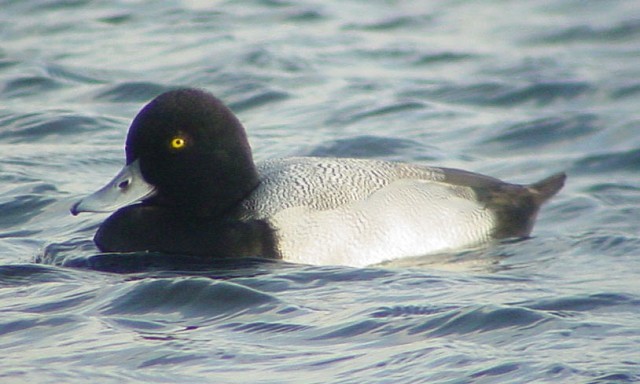
Lesser Scaup, Hogganfield Loch, Clyde (Photo: Chris Mcinerny)

Ferruginous Duck, Weston-super-Mare SW, Somerset & Bristol (Photo: Paul Bowyer)

Green-winged Teal, Farlington Marshes HWT, Hampshire (Photo: Andrew Madgwick)
A female Lesser Scaup was found (alongside a Ring-necked Duck) at Inch Island Lake (Co. Donegal) on 16th and a drake at Hogganfield Loch (Clyde) was joined by a second bird, another drake, on 21st, with both birds remaining to 22nd. A presumed returning drake Lesser Scaup was at Loch Leven (Perth & Kinross) on 22nd. Further Ring-necked Ducks were seen at Loch of Tingwall, Mainland (Shetland) on 17th–19th (with another at Loch of Clumlie, Mainland on 18th), two were at Leverburgh, Harris (Outer Hebrides) on 16th–17th and one remained on Inish Mor (Co. Galway) to 18th. On 21st, the drake Ring-necked Duck returned to Foxcote Reservoir (Buckinghamshire). In County Donegal, the drake Black Duck was seen again at Blanket Nook, Lough Swilly on 18th. Drake Ferruginous Ducks remained at Calvert Lake (Buckinghamshire) to 18th and again on 21st–22nd, at Amwell Gravel Pits (Hertfordshire) on 19th–22nd and at Weston-super-Mare (Somerset) to 22nd. The juvenile/first-winter American Wigeon was still on the Hayle Estuary (Cornwall) on 17th–19th while the adult drake was again at Fenham Flats (Northumberland) on 22nd. The drake Green-winged Teal remained at Farlington Marshes (Hampshire) and was still present from 16th–22nd, with another bird appearing at Woodwalton Fen (Cambridgeshire) on 21st. The second-winter drake King Eider was seen throughout the week at Appledore (Devon) to 22nd while, once again, the only Surf Scoter of the week was in Lunan Bay (Angus) to 19th. The drake Hooded Merganser continued to linger at Radipole Lake (Dorset) to 22nd.
A lone Honey Buzzard flew over Old Basing (Hampshire) and two more were seen at Albrighton (Shropshire), all on 21st, while single Rough-legged Buzzards were reported from Holkham (Norfolk) on 16th, over Drumbane, Garvagh (Co. Derry) on 17th and Hackthorpe (Cumbria) on 21st. In Scotland, a juvenile White-tailed Eagle was at St. Fergus (Aberdeenshire) on 18th.

American Golden Plover, Sennen, Cornwall (Photo: Tony Dixon)

Red-necked Phalarope, Ogmore Estuary, Glamorgan (Photo: Richard Smith)
Three American Golden Plovers were found on the Outer Hebrides this week: a single bird was at Arnol, Lewis on 17th with two birds at Ardivachar Point, South Uist the following day (with one remaining to 20th). In Cornwall, the juvenile seen last week moved to Sennen on 19th when one was seen again at Doonbeg (Co. Clare), where it remained to 21st. Another American Golden Plover was found at Clonakilty (Co. Cork) on 21st. A Baird's Sandpiper arrived at Burnham-on-Sea (Somerset) on 20th–21st and two juvenile White-rumped Sandpipers made their way to Tresco (Scilly) on 21st (with at least one still present on 22nd and one on St. Mary's later the same day), with another making landfall at Balgarva, South Uist (Outer Hebrides) on 22nd. Another Nearctic new arrival was a Long-billed Dowitcher found at Liscannor (Co. Clare) on 22nd. In Norfolk, the first-winter Wilson's Phalarope around the Cley Reserve and surrounding area was last seen on 16th. The flock of Pectoral Sandpipers at Loch Bee, South Uist (Outer Hebrides) topped eight late on 15th, with five birds still there on 16th and three remaining to 20th. Singles were noted on Tresco (Scilly) on 16th–21st, at Meare Heath (Somerset) on 17th and at Grove Ferry (Kent) on 18th–22nd, while two were at Tacumshin (Co. Wexford) on 18th. The Red-necked Phalarope remained on the Ogmore Estuary (Glamorgan) to 16th.

Ring-billed Gull, Kinneil Lagoon, Forth (Photo: Kris Gibb)
The second-winter probable Azorean Yellow-legged Gull was still being seen around Sennen (Cornwall) to 22nd. Numbers of Caspian Gulls edged up again this week, with two birds at Clifford Hill Gravel Pits (Northamptonshire) on 19th. Further singles were seen elsewhere in Northamptonshire, as well as in Bedfordshire, London, Suffolk and Staffordshire. Iceland Gulls were noted this week at Bragar, Lewis (Outer Hebrides), Sligo (Co. Sligo), Corbally Reservoir (Co. Antrim) and Liscannor (Co. Clare), while Glaucous Gulls were seen on mainland Orkney, at Ditchford GPs (Northamptonshire), with three seen on Fair Isle (Shetland) on 20th and further singles later in the week at Barvas, Lewis (Outer Hebrides) and Corbally Reservoir. A new Ring-billed Gull was found on the Alaw Estuary (Anglesey) on 18th, with another new bird arriving at Dundrum (Co. Down) on 19th. The adult was seen at Gosport (Hampshire) on 21st, along with adults again at Kinneil Lagoon (Forth) and at Portrush (Co. Antrim) and the Bann Estuary (Co. Derry). In Co. Galway, an adult was at Nimmo's Pier on 16th and 22nd. A juvenile White-winged Black Tern was seen briefly at Skipwith Common (North Yorkshire) on 16th and the adult Forster's Tern was again at Cruisetown Strand (Co. Louth) on 20th.

Great Grey Shrike, Heacham, Norfolk (Photo: Ray Roche)
A late splash of summer colour came in the form of a Golden Oriole on Tresco (Scilly) on 16th with it, or another, on St. Martin's on 18th. A Red-rumped Swallow was reported over Titchwell (Norfolk) on 17th. On Shetland, Bluethroats were at Channerwick, Mainland on 16th–17th and Fair Isle on 22nd, a Siberian Stonechat was at Collafirth, Mainland on 19th–20th and a Waxwing was in Lerwick, Mainland on 21st. Two Hoopoes appeared during the week, one at Dyce (Aberdeenshire) and one in a garden at Thakeham (West Sussex) on 20th. Two Wrynecks were seen on Scilly during the week (on St. Mary's and Gugh) and another was at Farlington Marshes (Hampshire) on 16th. A single Short-toed Lark was found on North Ronaldsay (Orkney) on 17th, and a Red-throated Pipit was on St. Agnes (Scilly) on the same date. Also on Scilly, indeed, still on St. Agnes, an Olive-backed Pipit was found on 20th and remained to 22nd. The week's second Red-throated Pipit was discovered on Lundy (Devon) on 22nd. At least 13 Richard's Pipits were noted this week with at least three birds on Scilly, two in Devon, one or two in Norfolk, along with notable singles in Somerset (at Knighton, on 16th), in Essex (at Coalhouse Fort, on 17th), in London (at Rainham Marshes on 22nd) and well inland at Annesley (Nottinghamshire) where last week's bird remained to 19th at least. Just three Red-backed Shrikes were seen this week, at Flamborough Head (East Yorkshire) on 16th, on Tresco (Scilly) on 18th and at Wouldham (Kent) on 21st–22nd. Up to 13 Great Grey Shrikes included two birds on Shetland, two in Hampshire and two in West Sussex.

Blyth's Reed Warbler, St. Agnes, Isles of Scilly (Photo: Stephen Allen)
A Blyth's Reed Warbler was an excellent find on St. Agnes (Scilly) on 16th, and the bird showed well to visitors until 18th, before surfacing again on 22nd, complete with a shiny new ring. There was just one Radde's Warbler to report this week, at Start Point (Devon) on 16th. Numbers of Yellow-browed Warblers were almost impossible to estimate, but around 90 birds would be a minimum guess for the past few days. Figures on Scilly and in Cornwall are tough to work out with any great accuracy but a minimum of 30 were around the islands, with a further 15–20 on the nearby mainland. Seven birds were seen on Lundy (Devon) on 17th and four were seen on Cape Clear Island (Co. Cork) on 16th (with 200+ Coal Tits there on 17th, part of a significant movement of the species across Ireland this autumn). A Barred Warbler was seen at Exnaboe, Mainland (Shetland) on 16th with another at Mizen Head (Co. Cork) on 17th–20th. Also at Mizen Head on 17th was a Red-breasted Flycatcher, one of at least ten seen during the week. Four birds were on Scilly (on St. Mary's, Tresco and St. Agnes), an adult male was at Mullion, Lizard (Cornwall) on 22nd, and another was still on South Uist (Outer Hebrides) during the week.

Hornemann's Arctic Redpoll, Norwick, Unst, Shetland (Photo: Mike Pennington)

Common Rosefinch, Toab, Mainland, Shetland (Photo: Tony Mills)
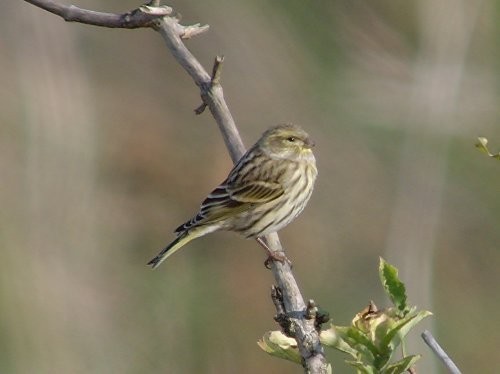
Serin, Rainham Marshes RSPB, London, Greater (Photo: Richard Bonser)

Rose-coloured Starling, Pendeen, Cornwall (Photo: Tony Dixon)

Red-eyed Vireo, Sennen, Cornwall (Photo: Tony Dixon)

Shore Lark, Upton Warren NR, Worcestershire (Photo: Rob Smith)
Two Hornemann's Arctic Redpolls were on Shetland this week: one was at Norwick, Unst on 18th–21st (along with a dozen Greenland Redpolls) with another at North Roe, Mainland on 19th. Also on Shetland were two single Little Buntings, at Isbister, Whalsay on 16th and at Skaw, Unst (along with a Common Rosefinch) on 18th. Two further Little Buntings were seen on Scilly this week, on St. Mary's on 18th–21st, and another on St. Agnes on 21st. Further Common Rosefinches were seen at Church Cove (Cornwall) and Toab, Mainland (Shetland) on 18th, while a Serin was seen at Hope Point (Kent) on the same date. Three Serins were a great find at Rainham Marshes (London) on 22nd (with the already-mentioned Richard's Pipit and a Dartford Warbler there too). The juvenile Rose-coloured Starling remained at Pendeen (Cornwall) to 20th while in Kent, at Dungeness, an adult Rose-coloured Starling was seen on 18th. The Red-eyed Vireo at Sennen (Cornwall) was still present to 17th while one of the records of the week was the Red-eyed Vireo that appeared on the Isle of Wight, at St. Catharine's Point, on 18th, a first for the island. An inland Shore Lark at Upton Warren (Worcs) was notable.
Photo of the Week
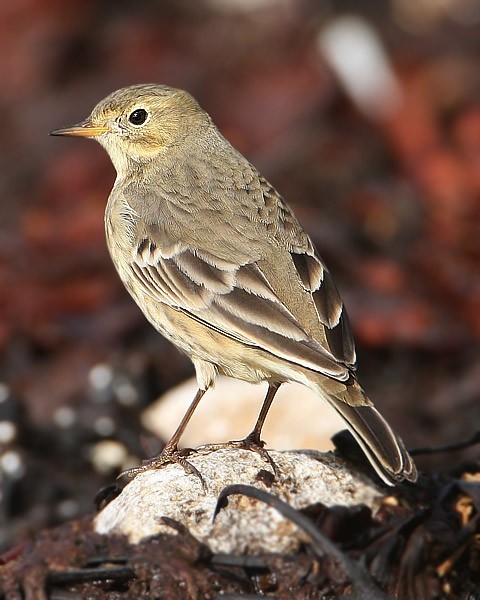
Buff-bellied Pipit, Bryher, Isles of Scilly (Photo: Gary Thoburn)
This October has been among the best ever for rarities in the UK and, although most of us don't get to see these birds in the flesh, we can still enjoy them vicariously thanks to the photos uploaded by our contributors. As usual, the Scilly Isles have had a good share of the rarities and, this week, we've had high-quality photos of no fewer than five great birds sent in by Gary Thoburn. Not content to settle for record shots, Gary has captured all these individuals in fine detail, each with the pose, lighting and background normally seen only in photos of common birds. Our pick of the set is the beautifully posed portrait of a Buff-bellied Pipit, which perfectly illustrates how attention can be paid to aesthetics even in rarity shots.
Other notable photos

Jay, Wigan Flashes LNR, Manchester, Greater (Photo: Mike Atkinson)

Little Egret, Brownsea Island NT, Dorset (Photo: Nigel Forrow)
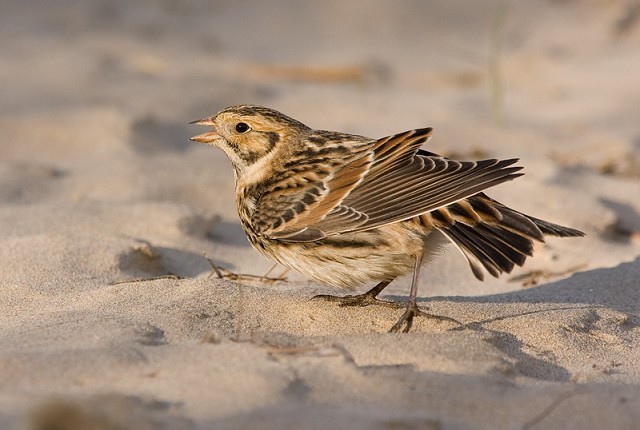
Lapland Bunting, Titchwell RSPB, Norfolk (Photo: Matt Latham)

Grey Heron, Radipole Lake RSPB, Dorset (Photo: Steve Copsey)

Red-necked Phalarope, Ogmore Estuary, Glamorgan (Photo: Richard Smith)

Pectoral Sandpiper, Llanrhystud, Ceredigion (Photo: Melvin Grey)

Ring-necked Parakeet, Bushy Park, London, Greater (Photo: Richard Steel)

European Bee-eater, Turkey (Photo: Rudi Debruyne)

Dipper, Lathkill Dale NNR, Derbyshire (Photo: Robert Askew)

Squacco Heron, Spain (Photo: Howard Kearley)

Lapwing, Draycote Water, Warwickshire (Photo: Barry Boswell)

hybrid, Needham Market, Suffolk (Photo: Jon Evans)

